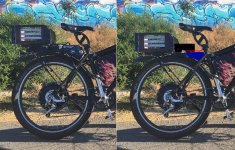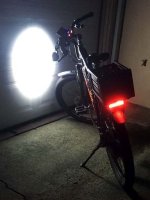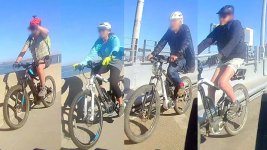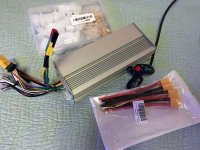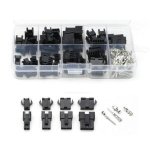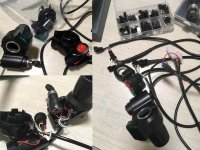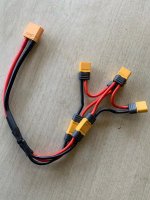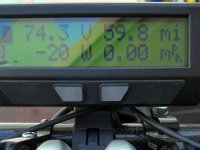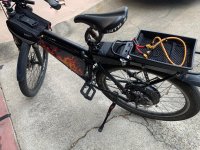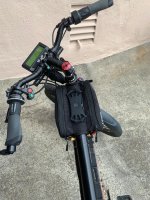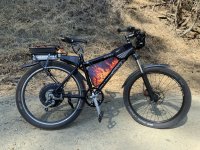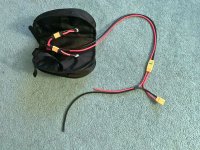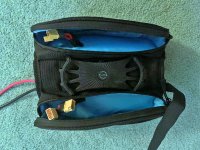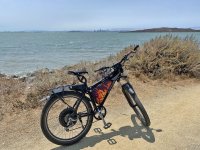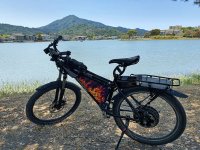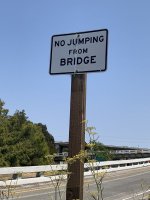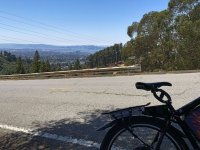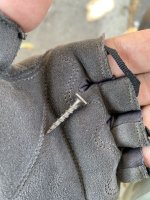Finished mounting my switch box and making most of the connections, but still need to wire my buck converters for running the rear lights and 12v subsystem (bought this 4 wire harness for bringing the battery level and 12v power to the switch box https://www.amazon.com/gp/product/B07PB3YRBY/ref=ppx_yo_dt_b_asin_title_o01_s00?ie=UTF8&psc=1). At least the headlight is wired, since it's battery level voltage. I stole 5v from my throttle to run the meter LED.
Mounted a new trigger throttle (thanks amberwolf for the suggestion), but not before opening it up and tweaking the spring to reduce spring tension to about a third. I'll be testing it during the week, but so far it's pretty easy to use with a little more precision than the old throttle. I may chop off some of the paddle, since with the reduced tension, it can be short and still be easy to use.
Lastly, got rid of my boost/regen pushbutton switch and added another toggle on the switch panel. I decided with the new trigger throttle, it's just as easy to tap it to get the boost while on PAS, and a toggle will work better for locking the throttle for regen. With the switch off, the throttle works normally and the bike will coast when letting off the throttle. In the on position, the throttle is sort of locked to the motor, so letting off causes the motor to brake (like riding around in 1st gear with a manual tranny), which works great when navigating past foot traffic. Also replaced the pot with fixed resistors.
EDIT: That wire harness is way too thick, so it's going back. Back to the original plan, two lengths of Walmart black extension cord. :|
Oh ya, I figured out that the Statorade is working. Not sure if it's because I was using a lot a throttle doing testing this afternoon, but after about 45 minutes of riding around, including some pretty steep stuff, I stopped to take a break and felt the motor. Pretty hot, or at least the hottest I've ever felt it.
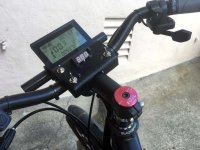
EDIT: 10-08-19
I noticed at battery level voltages, my LED meter is reading high by 0.2 volts when measuring at the battery terminal with my multi-meter. At the same time, my LCD3 reads 0.2 volts low. Interestingly, the little cheapo LED meter has a calibration pot on the rear, so I'm going to calibrate it to be accurate at the battery terminals, even though the difference it tiny.
EDIT: 10-11-19
I’m loving this trigger throttle after a week. It’s really easy to use with no jerkiness or dead spots, and the reduced spring tension makes it really easy on my thumb. Now my bars feel perfect too.
I’m going to move the regen switch next to the throttle, since I found I really need to be able to quickly disengage it, so reaching over to the switch panel wasn’t cutting it.
Got my tail lights in the mail yesterday, so only waiting for my smaller buck converter before finishing off my lighting and 12V subsystem.
EDIT: 10-13-19
Used some scrap ABS for the switch plate for relocating the regen switch to the trigger throttle area. The current switch will tap into the signal wire instead of the ground, so I can use it as an emergency throttle cutoff.
Bent the ABS after heating it so that it will curve and meet the handlebar, and hide the wiring a little. It's notched so that the flat part can either be hot glued or epoxied to the throttle's handlebar mount, and housing. The wires can go directly into the housing, or alternatively splice into the throttle cable right behind the plate.
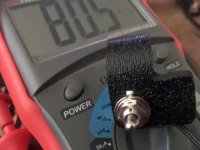
I went back to using a pot instead of fixed resistor, since I switched throttles and need to re-tune it anyway, but also by mounting on the switch plate, it's easily accessible. i also switched to a 200 ohm pot, since the resistance that works is below 100 ohms, so the pot allows for really fine tuning.
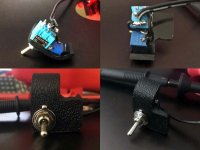
Test fit, not attached, but this is how where it will mount, within easy thumb reach.

I covered/sealed all of the connections in the back with black hot glue, just for some weather protection.
EDIT: 10-20-19
I got tired of waiting for the smaller 12v buck converter to arrive, so just went ahead and wired up the 15A one and finishing "most" of the switch panel.
I had a minor setback, and fried the LED voltmeter by taking a shortcut and drilling and access hole from the back of the ABS panel. Went a little to far...ordered a replacement, but in blue, thanks to a tip from pwd on one of his threads. Dremeled the access hole to make sure the new meter will be easy to adjust, so should take a few minute to install once I get the new one.
I mounted the 12v buck converter to the front of my cargo box. Used a Molex connector between it and the rest of the wiring to make it easy to remove the box when I want to.

I'm glad my connector box covers that snarl of wires! So now the top left switch is the emergency throttle cutoff, the lower left is the 12v subsystem, right are the lights, voltmeter in the center.
EDIT: 10-24-19
Got the new voltmeters, 2 each red, green, and blue. Good thing I got extras, since if fried one of the new ones again, attempting to calibrate the voltage. I figured out that it was safer to turn off the power, adjust, and power back up to avoid making the same mistake. Took longer, but got it dialed in perfectly after 4 tries.
Re-solder everything since I changed the configuration slightly to avoid bringing too many battery level voltage wires up front. After putting it all back together, including wiring up the rear light, I encountered a hiccup. The main switch for the 12v subsystem wasn't working; permanently on. Replaced the switch and then figured out the problem. The mini toggles couldn't handle the voltage and you could see it arcing each time it was turned on and off, eventually welding itself permanently on. Ugh. I'll need to order a heavy duty toggle for the main switch, but can use my main battery shutoff until then to power everything down.
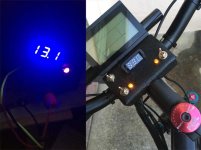
The blue LEDs are great though. I can see them in daylight, but will wash out in direct sunlight, but it's way brighter than the red ones. :thumb:
EDIT: 10-26-19
Changing direction. Going to use solid state relays and skip bringing any battery level voltage wires up front. I can keep the existing switches (replace the burnt one) and LEDs, and use the controller's 5v for operating the relays. Since my headlight can operate at 12v, I'll switch that over as well. This also prevents ever leaving the lights and 12v converter on, since it all shuts down with the controller.
Mounted a new trigger throttle (thanks amberwolf for the suggestion), but not before opening it up and tweaking the spring to reduce spring tension to about a third. I'll be testing it during the week, but so far it's pretty easy to use with a little more precision than the old throttle. I may chop off some of the paddle, since with the reduced tension, it can be short and still be easy to use.
Lastly, got rid of my boost/regen pushbutton switch and added another toggle on the switch panel. I decided with the new trigger throttle, it's just as easy to tap it to get the boost while on PAS, and a toggle will work better for locking the throttle for regen. With the switch off, the throttle works normally and the bike will coast when letting off the throttle. In the on position, the throttle is sort of locked to the motor, so letting off causes the motor to brake (like riding around in 1st gear with a manual tranny), which works great when navigating past foot traffic. Also replaced the pot with fixed resistors.
EDIT: That wire harness is way too thick, so it's going back. Back to the original plan, two lengths of Walmart black extension cord. :|
Oh ya, I figured out that the Statorade is working. Not sure if it's because I was using a lot a throttle doing testing this afternoon, but after about 45 minutes of riding around, including some pretty steep stuff, I stopped to take a break and felt the motor. Pretty hot, or at least the hottest I've ever felt it.

EDIT: 10-08-19
I noticed at battery level voltages, my LED meter is reading high by 0.2 volts when measuring at the battery terminal with my multi-meter. At the same time, my LCD3 reads 0.2 volts low. Interestingly, the little cheapo LED meter has a calibration pot on the rear, so I'm going to calibrate it to be accurate at the battery terminals, even though the difference it tiny.
EDIT: 10-11-19
I’m loving this trigger throttle after a week. It’s really easy to use with no jerkiness or dead spots, and the reduced spring tension makes it really easy on my thumb. Now my bars feel perfect too.
I’m going to move the regen switch next to the throttle, since I found I really need to be able to quickly disengage it, so reaching over to the switch panel wasn’t cutting it.
Got my tail lights in the mail yesterday, so only waiting for my smaller buck converter before finishing off my lighting and 12V subsystem.
EDIT: 10-13-19
Used some scrap ABS for the switch plate for relocating the regen switch to the trigger throttle area. The current switch will tap into the signal wire instead of the ground, so I can use it as an emergency throttle cutoff.
Bent the ABS after heating it so that it will curve and meet the handlebar, and hide the wiring a little. It's notched so that the flat part can either be hot glued or epoxied to the throttle's handlebar mount, and housing. The wires can go directly into the housing, or alternatively splice into the throttle cable right behind the plate.

I went back to using a pot instead of fixed resistor, since I switched throttles and need to re-tune it anyway, but also by mounting on the switch plate, it's easily accessible. i also switched to a 200 ohm pot, since the resistance that works is below 100 ohms, so the pot allows for really fine tuning.

Test fit, not attached, but this is how where it will mount, within easy thumb reach.

I covered/sealed all of the connections in the back with black hot glue, just for some weather protection.
EDIT: 10-20-19
I got tired of waiting for the smaller 12v buck converter to arrive, so just went ahead and wired up the 15A one and finishing "most" of the switch panel.
I had a minor setback, and fried the LED voltmeter by taking a shortcut and drilling and access hole from the back of the ABS panel. Went a little to far...ordered a replacement, but in blue, thanks to a tip from pwd on one of his threads. Dremeled the access hole to make sure the new meter will be easy to adjust, so should take a few minute to install once I get the new one.
I mounted the 12v buck converter to the front of my cargo box. Used a Molex connector between it and the rest of the wiring to make it easy to remove the box when I want to.

I'm glad my connector box covers that snarl of wires! So now the top left switch is the emergency throttle cutoff, the lower left is the 12v subsystem, right are the lights, voltmeter in the center.
EDIT: 10-24-19
Got the new voltmeters, 2 each red, green, and blue. Good thing I got extras, since if fried one of the new ones again, attempting to calibrate the voltage. I figured out that it was safer to turn off the power, adjust, and power back up to avoid making the same mistake. Took longer, but got it dialed in perfectly after 4 tries.
Re-solder everything since I changed the configuration slightly to avoid bringing too many battery level voltage wires up front. After putting it all back together, including wiring up the rear light, I encountered a hiccup. The main switch for the 12v subsystem wasn't working; permanently on. Replaced the switch and then figured out the problem. The mini toggles couldn't handle the voltage and you could see it arcing each time it was turned on and off, eventually welding itself permanently on. Ugh. I'll need to order a heavy duty toggle for the main switch, but can use my main battery shutoff until then to power everything down.

The blue LEDs are great though. I can see them in daylight, but will wash out in direct sunlight, but it's way brighter than the red ones. :thumb:
EDIT: 10-26-19
Changing direction. Going to use solid state relays and skip bringing any battery level voltage wires up front. I can keep the existing switches (replace the burnt one) and LEDs, and use the controller's 5v for operating the relays. Since my headlight can operate at 12v, I'll switch that over as well. This also prevents ever leaving the lights and 12v converter on, since it all shuts down with the controller.


